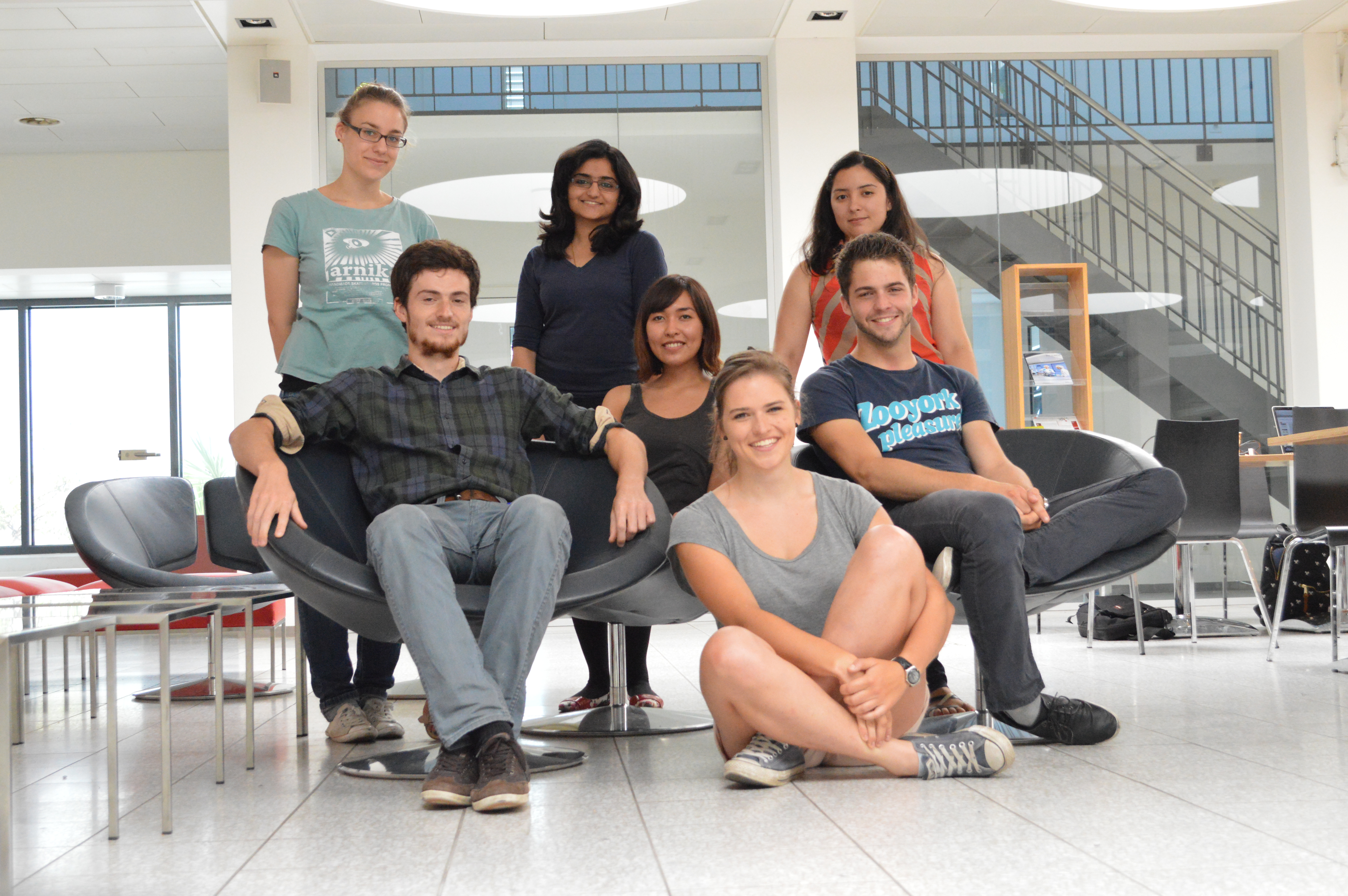Team:ETH Zurich
From 2013.igem.org
| Line 13: | Line 13: | ||
<li> | <li> | ||
<a href="/Team:ETH_Zurich/Project"><img src="https://static.igem.org/mediawiki/2013/8/8f/Minetocoli3.png"/></a> | <a href="/Team:ETH_Zurich/Project"><img src="https://static.igem.org/mediawiki/2013/8/8f/Minetocoli3.png"/></a> | ||
| - | <p style="font-size:15px" align="justify"><b>From Minesweeper to Colisweeper</b><br> | + | <p style="font-size:15px" align="justify"><b>From Minesweeper to Colisweeper</b><br> Colisweeper is a biological version of the Minesweeper computer game. The minefield is replaced by mine and non-mine colonies on an agar plate. Quorum sensing molecule OHHL communicates between colonies which are designed to express different orthogonal hydrolases depending on the signal processed. By pipetting a colorless multi-substrate mix onto mine or non-mine colonies, color appears and indicates the next logical move for the player. If you are certain of a mine colony, you can use a second substrate solution to flag the mine. |
</p> | </p> | ||
</li> | </li> | ||
| Line 21: | Line 21: | ||
<map name="map1" id="map1"><area shape="poly" alt="" title="" coords="291,95,125,97,126,120,291,120,291,131,315,108,290,82,290,82" href="https://2013.igem.org/Team:ETH_Zurich/Experiments_2" target="" /><area shape="poly" alt="" title="" coords="577,163,547,171,524,205,525,250,543,288,573,299,607,284,624,250,625,211,611,182,591,164" href="https://2013.igem.org/Team:ETH_Zurich/Project" target="" /><area shape="poly" alt="" title="" coords="483,331,454,317,404,313,351,335,330,375,355,411,394,431,438,432,481,420,508,391,509,364,501,345,501,345" href="https://2013.igem.org/Team:ETH_Zurich/Experiments_3" target="" /><area shape="rect" alt="" title="" coords="225,261,358,286" href="https://2013.igem.org/Team:ETH_Zurich/Experiments_6" target="" /><area shape="circle" alt="phoa" title="PhoA" coords="116,340,19" href="https://2013.igem.org/Team:ETH_Zurich/Experiments_7" target="" /><area shape="circle" alt="GusA" title="GusA" coords="183,324,21" href="https://2013.igem.org/Team:ETH_Zurich/Experiments_7" target="" /><area shape="circle" alt="LacZ" title="LacZ" coords="158,365,22" href="https://2013.igem.org/Team:ETH_Zurich/Experiments_7" target="" /><area shape="circle" alt="LacZ" title="LacZ" coords="104,398,20" href="https://2013.igem.org/Team:ETH_Zurich/Experiments_7" target="" /><area shape="circle" alt="Aes" title="Aes" coords="189,414,22" href="https://2013.igem.org/Team:ETH_Zurich/Experiments_7" target="" /><!-- Created by Online Image Map Editor (http://www.maschek.hu/imagemap/index) --></map> | <map name="map1" id="map1"><area shape="poly" alt="" title="" coords="291,95,125,97,126,120,291,120,291,131,315,108,290,82,290,82" href="https://2013.igem.org/Team:ETH_Zurich/Experiments_2" target="" /><area shape="poly" alt="" title="" coords="577,163,547,171,524,205,525,250,543,288,573,299,607,284,624,250,625,211,611,182,591,164" href="https://2013.igem.org/Team:ETH_Zurich/Project" target="" /><area shape="poly" alt="" title="" coords="483,331,454,317,404,313,351,335,330,375,355,411,394,431,438,432,481,420,508,391,509,364,501,345,501,345" href="https://2013.igem.org/Team:ETH_Zurich/Experiments_3" target="" /><area shape="rect" alt="" title="" coords="225,261,358,286" href="https://2013.igem.org/Team:ETH_Zurich/Experiments_6" target="" /><area shape="circle" alt="phoa" title="PhoA" coords="116,340,19" href="https://2013.igem.org/Team:ETH_Zurich/Experiments_7" target="" /><area shape="circle" alt="GusA" title="GusA" coords="183,324,21" href="https://2013.igem.org/Team:ETH_Zurich/Experiments_7" target="" /><area shape="circle" alt="LacZ" title="LacZ" coords="158,365,22" href="https://2013.igem.org/Team:ETH_Zurich/Experiments_7" target="" /><area shape="circle" alt="LacZ" title="LacZ" coords="104,398,20" href="https://2013.igem.org/Team:ETH_Zurich/Experiments_7" target="" /><area shape="circle" alt="Aes" title="Aes" coords="189,414,22" href="https://2013.igem.org/Team:ETH_Zurich/Experiments_7" target="" /><!-- Created by Online Image Map Editor (http://www.maschek.hu/imagemap/index) --></map> | ||
| - | <p style="font-size:15px" align="justify"><b>Information Processing</b><br> Our non-mine colonies are designed to distinguish between different concentrations of OHHL | + | <p style="font-size:15px" align="justify"><b>Information Processing</b><br> Our non-mine colonies are designed to distinguish between different concentrations of OHHL and translate this information into expression of different sets of hydrolases. They are equipped with mutated LuxR promoters with different OHHL sensitivities which serve as highpass filters. The promoters were created using site-saturation mutagenesis. Through mutation of the LuxR binding sites we were able to tune the promoters to different OHHL affinities .</p> |
</li> | </li> | ||
| Line 42: | Line 42: | ||
<li> | <li> | ||
<a href="/Team:ETH_Zurich/Human"><img src="https://static.igem.org/mediawiki/2013/5/5d/Humanpractice_%281%29.png" /></a> | <a href="/Team:ETH_Zurich/Human"><img src="https://static.igem.org/mediawiki/2013/5/5d/Humanpractice_%281%29.png" /></a> | ||
| - | <p style="font-size:15px" align="justify"><b>Human practices</b><br> | + | <p style="font-size:15px" align="justify"><b>Human practices</b><br>Inspired by our Colisweeper project, we analyzed the relationship between synthetic biology and games. For one thing synthetic biology can be used to play common games in a new way, possibly for educational purposes or as a basis for proof-of-principle experiments for new circuits. More recently synthetic biologists also started to use games as a research tool, an innovative approach to make use of crowd-sourcing and distributed computing. We want to find correlations and discuss possible consequences for Synthetic Biology.</p> |
</li> | </li> | ||
</ul> | </ul> | ||
Revision as of 12:00, 19 September 2013
Colisweeper is an interactive, biological version of the Minesweeper computer game, based on luxI/luxR quorum sensing and chromogenic enzymatic reactions. The goal is to clear an agar “minefield” without detonating mines.
Genetically engineered Escherichia coli colonies are used as sender-cells (mines) and receiver-cells (non-mines). Mines secrete the signaling molecule N-(3-oxohexanoyl)-l-homoserine lactone (OHHL) whereas non-mines process the signal. To distinguish between OHHL-levels, a library of PLuxR promoters with various sensitivities was created through site-saturation mutagenesis. High-pass filters were constructed to control the expression of different orthogonal hydrolases in non-mines, depending on the number of surrounding mines.
Additionally, the mines express their own hydrolase.A spatiotemporal reaction-diffusion model was established to evaluate and improve the system. To play Colisweeper, a colorless substrate solution is pipetted onto a colony of choice. The result is a defined color change within minutes, allowing identification of the played colony and the number of mines surrounding it.
 "
"













